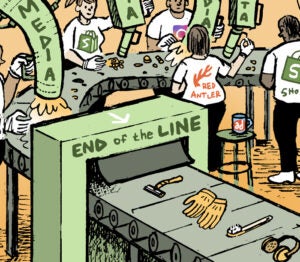 “Data-Driven Thinking” is written by members of the media community and contains fresh ideas on the digital revolution in media.
“Data-Driven Thinking” is written by members of the media community and contains fresh ideas on the digital revolution in media.
Today’s column is written by Matt Rosenberg, senior vice president of marketing at 140 Proof.
As we wander around the web, there are so many ads talking, blinking and popping out at you that it can drive you nuts if you try to pay attention to it. But few make the effort.
Banner blindness is no surprise – it’s an adaptive response to all that noise. It’s not the audience’s fault. But banner blindness devalues the media, forcing publishers to increase ad placements to maintain revenue. Since the only clear way to monetize is to advertise, this creates a vicious cycle.
But then last month, we saw one possible solution from Google. Invitations began showing up for the Contributor by Google program, which aims to help people see fewer ads while continuing to flow revenue to publishers. It is genius.
Although ad-blocking software is part of that adaptive behavior by the audience, it’s a real threat to publishers. Ad-blocking software is a blunt instrument that may temporarily satisfy audiences – until the lights go out on publishers whose content was funded by those blocked ads.
Google’s insight: We don’t want publishers we like to go out of business, so instead of the blaring ads, consumers might be willing to contribute a few dollars to publishers to withhold the ads.
Anti-Advertising?
Google’s program doesn’t purport to remove all ads. The number of ads blocked will be in some proportion to the amount of money contributed. Even at the $10 maximum contribution level, consumers will only miss half of the ads, at most. The money they pay will be spread roughly proportionally to the sites they visit. The sites that participate are all part of Google’s display network.
But those holes in the page won’t disappear. Content won’t cover those IAB-sized boxes. Instead, banner ads are replaced with images of contributors’ choice, from a variety of options ranging from empty space to cat pictures.
To many, this feels like a confusingly anti-advertising program from the world’s leading display advertising network. Pitched as “an alternative way to fund the web,” some wonder if this is cynical PR, an experiment to see if ad recall goes up with fewer claims made on attention, or if Google is testing future business models.
AdExchanger Daily
Get our editors’ roundup delivered to your inbox every weekday.
Daily Roundup
But they haven’t done an anti-advertising thing. They are selling banner ads – in the form of cat photos and empty spaces. They are just selling them to consumers instead of to brands. They appear to be taking the contributions, applying a CPM and instead of serving a brand ad to the contributor, they are serving them a cute kitten. Contributors are paying for that kitten.
Low Risk
Since Google doesn’t control every ad call within its network, it can’t stop ads that come from elsewhere. While it can’t “block” every ad, it estimates that for $10 it can block 25% to 50% of ads. Google is certain that the several thousand impressions that can be bought for $10 will make that kind of dent in someone’s monthly ad consumption.
Though there are listed partners for the program, with so much of the Internet part of Google’s network, there is little risk to any publisher. They are still receiving contributions in the form of ad revenue from Google. There is no extra accounting for the “contributions.” It’s just business as usual for an ad-supported site.
Publishers may just love it – no drop in yield, but a potentially less ad-numbed audience.
It’s completely understandable that people would be weary of the massive numbers of display ads the web brings them. Reducing clutter is a great goal, and if done by reducing the number of ad units on a page, that could also raise prices.
But rather than developing something like a subscription service that crowdfunds publishers with the reward of a less cluttered page, Google has just found a different buyer for the ads: you. Now make them take you for a mani-pedi.
Follow 140 Proof (@140proof) and AdExchanger (@adexchanger) on Twitter.












